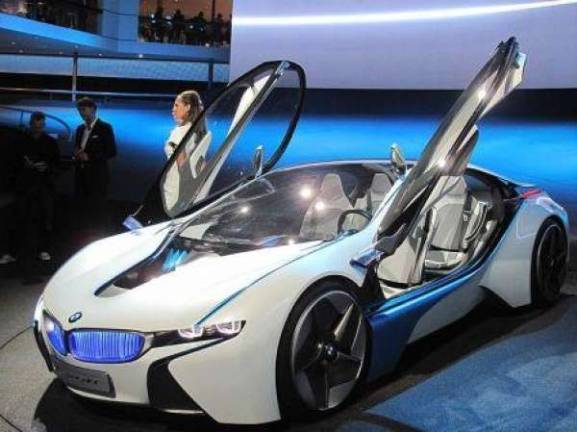The Possible of Mission: Impossible, Part TWO

In my last post, I looked at what was up with the HUD Contact Lenses and Electroadhesive 'Spiderman' Gloves featured in Mission:Impossible - Ghost Protocol. Today we're going to see the Magnetic Levitation Suit used by The Hurt Locker star, Jeremy Renner, and the real star of M:I-GP, the BMW i8 concept car. Item 3: The Mag-Lev Suit. During a particularly suspenseful scene, Jeremy Renner is rigged up in a chain mail Magnetic Levitation Suit that he then uses to save the world. By floating. To be totally honest there's nothing exceptionally mind blowing about a Magnetic Levitation suit except how little real world purpose it would serve. I mean, most of the applications I could think of for this suit/lev-bot combo would be easily achieved with actual things. I'm going to go so far as to say that the only instance I can think of where I would really need to have this suit would be the exact situation in which it was used in the movie. But, whatever. Is it possible? Absolutely. Magnetic Levitation has been around for a long time. We often use it effectively (#ShanghaiMagLev) to lift objects many thousands of times heavier than Jeremy Renner. There are some issues that one would come up against though. Ifyou'veever held two magnets of opposing polarities close enough to where they repel, for example, you'll understand why stability would be a problem. Then if the lev-bot were using electromagnetic levitation like we'd see with superconductors, the device would have to be cooled to extreme degrees to stop overheating. No spoilers, but anybody who saw the movie will get why-unless the bot was strapped with some incredible super-coolant-there's no possible way that could've been a superconducting magnet. There have been [recent experiments by NASA](http://www.dailymail.co.uk/sciencetech/article-1212553/NASA-levitates-mice-using-magnets-simulate-space-travel.html), looking to simulate anti-gravity, where scientists created a magnetic field strong enough to levitate the water molecules within the body of a living mouse. Whoa. RIP NASA. What morons thought it was a good idea to quit on Outer Space? It's only, like, 99.99999?. percent of everything. OOF! I need to calm down. So! While it's theoretically possible that a suit like this could be created, it's unlikely that anybody's going to take the time to think up solutions for the above problems anytime soon. Mostly because, like I said, why would you need an extremely limited levitation suit? Item 4: The Car. There's plenty of information out about the BMW i8, scheduled for release, so I'll just breeze through the basic specs: The car can run on electricity only for 22 miles. Able to recharge in two hours from a domestic power source, it gets an unheard of 87mpg, and still satisfies the Wild Child in all of us with a 0 to 60 of just four seconds. Whatever! What I'm really stoked on here is the Windshield Display technology. Now, in the movie we saw a full, gesture controlled 3D environment, but for a few obvious reasons (#hugedistraction #askingforit #recklessmajority) that won't be a option on the consumer models anytime soon. What we can look forward to is a still very impressive full color 3D Heads Up Display that provides basic information to drivers without the need to take your eyes off the road. Like with the technology for transparent displays mentioned in my last post, HUD in cars has been around for a bit now. But as we'll see the future of this is still wide open. At CES 2012 (Consumer Electronics Show) this week, Audi presented their take on it with a [three-panel gesture controlled setup](http://www.youtube.com/watch?v=PoBs_bZWyg0a) that boasts stunningly clear graphics. Also showing some promising in-vehicle displays were GM and Mercedes-Benz, but still, none of these will be anything close to what we saw in M:I-GP. The real obstacle here is distractibility. The tech we're talking about is good to go as far as components are concerned: 1.Transparent displays are going to be what's up as this "the-winner-is-thinner" computing trend comes to a head. (Samsung was doing a little bragging at CES with their [Transparent LCD Smart Window](http://global.samsungtomorrow.com/?p=9034)#AwesomeScience). How much thinner can you get than a window? 2.Gesture control isn't perfect yet. But with the technology introduced by the Microsoft Kinect game system, which will be built-in to new TVs (Samsung again), there's no reason why they couldn't slap it into a car. 3.GPS navigation systems are old news in cars. Here they just need to make an eight inch leap from the dash to the windshield. No biggie. If only the driver could keep their eyes on the road. But if it's all the driver's fault for being so easily distracted, then what's keeping us passengers from having some fun? According to Toyota: Nothing! The [Toyota Window To The World](http://nypress.com/%E2%80%9Chttp://corporatemedia.toyota.eu/PressReleases/Pages/CorporatePressRelease.aspx?pressReleaseId=661&returnUrl=%2fPages%2fdefault.aspx&source=Corporate#)concept turns the backseat windows into actual transparent touchscreen display. Using cameras and sensors mounted onto the car's exterior Toyota is able to provide an interactive experience while on the road. Passengers will be able to use multi-touch and graphics technology to doodle on the glass, zoom in to specific portions of the world beyond, and even point at real pieces of the landscape which the window/computer will then translate as text in the local language wherever you're driving. I.E. you pass a house in Mexico and get a little 'casa' floating across the display. Actually cool! I predict this is going to forever change parental road annoyances from "Are we there yet?" to "Do we have to get out of the car? Don't wanna!" While the Future of Stuff can never come too soon, we can safely say that splattered bugs on your windshield are about to get a whole lot more annoying in just the next few years!